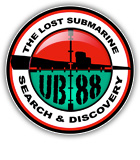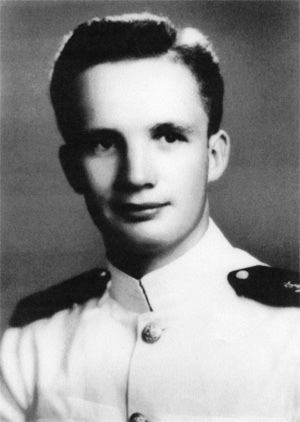
In memory of Ensign Charles E. Butler, U.S. Navy
Lost at sea February 10, 1950
Photo courtesy of Jerry Wilson
Missing Navy Fighter Plane
Found Off Dana Point, CA
Dive Report
by Kendall Raine
The wreckage of a Navy F4U Corsair was located off the
coast of Dana Point in 2010 and has recently been
identified. Flown by Ensign Charles E. Butler, the
Corsair disappeared while flying in formation through
cloud cover on February 10, 1950. While the Navy
conducted an intensive search at the time, no evidence of
the plane or pilot was ever located and its location
remained a mystery until last year.
Operating on a request from the family of a missing
crewman who was lost aboard a twin-engine military
aircraft, Gary Fabian located a promising target on
multibeam sonar in the vicinity of the reported accident.
Capt. Ray Arntz conducted a side scan sonar evaluation of
the target and executed a quick bounce dive to confirm
the identity of the wreckage. Ray confirmed the presence
of a single radial aircraft engine of a type similar to
the plane we were looking for. His side scan image of the
site revealed numerous depressions within a 100 foot
radius. Apart from the one engine Ray found, the wreckage
was extremely fragmented. On December 7, 2010 John Walker
and I returned with to the wreck with Capt. Ray and Capt.
Kyaa Heller to conduct a scooter based video
documentation of the site in hopes of confirming the
exact ID of the aircraft. Our plan was to drop on the
most concentrated area of the wreck and then conduct a
circular scooter search of possible outlying sections of
wreckage. Our target plane ditched and we hoped to find
sections of the fuselage intact.
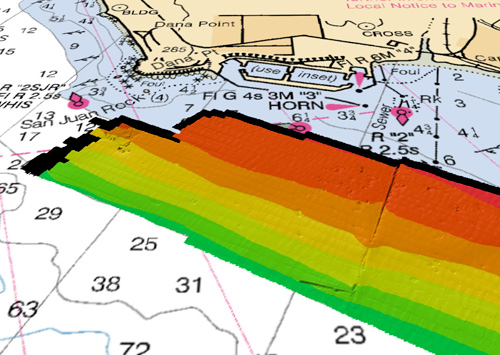
3D perspective view of Dana Point multibeam sonar survey.
Multibeam data provided by SANDAG. Image by Gary Fabian.
Larger Image
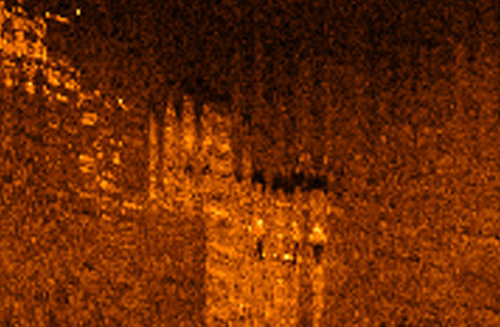
Side scan sonar image of aircraft debris field. Image
recorded by Ray Arntz.
As usual, we used a weighted drop line over the wreck
site in order to live boat the dive. There was about a
knot of current on the surface along with a south swell.
By the time John and I got in the water and squared away
we were 75 yards down current of the ball and were glad
to have the scooters to motor up to the drop point.
Visibility was limited and green on top and only opened
up below about 50 feet. As we neared the bottom I was
distressed to see the drop weight merrily bouncing across
the mud bottom. It was maybe 20 minutes since we dropped
the ball so I guessed we were between 400 and 600 feet
down current of the wreck site. Fortunately, the bottom
was soft mud and, with some effort, we were able to make
out a snail trail from the drop weight. We cranked up the
scooters and followed the trail for about five minutes
until we came across a large radial aircraft engine crank
case. Most of the cylinder heads were missing but the
four bladed prop was unmistakable along with two rows of
nine cylinders in a radial case. The engine was
consistent with a Wright R-3350, belonging to our target
plane. The four bladed prop was correct, as well.
Extending from the back of the block was a long crank
shaft which had two opposing impellers and a series of
reduction gears attached. These appeared to be part of a
supercharger which, again, was consistent with our target
plane.
All underwater photos by John
Walker
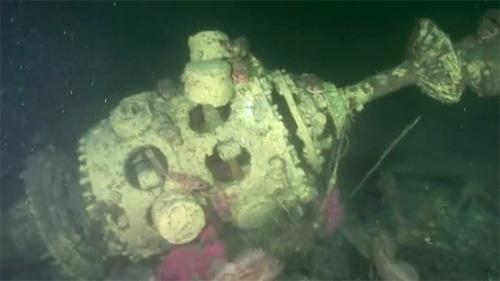
Eighteen cylinder radial engine with two-stage
supercharger
We searched the immediate area and came across what
looked like a landing gear assembly and a diamond tread
aircraft tire. A cylindrical oil cooler lay in the mud
alongside pieces of exhaust manifold, cylinder barrels
and other engine parts.

Aircraft tire with diamond tread pattern
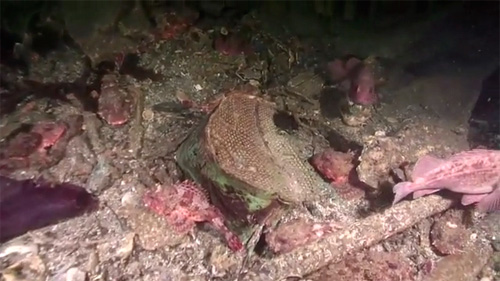
Cylindrical oil cooler
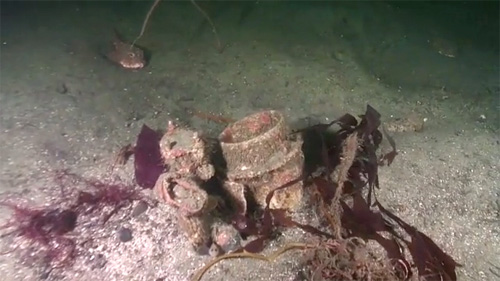
Cylinder barrel and exhaust collector
The amount of debris fragmentation was disturbing since
we knew our target plane successfully ditched. The depth
was such that wave action shouldn’t have broken the
plane down so extensively. Nevertheless, we felt
increasingly sure we had our plane.
John and I then started a circular search. We tied into
the supercharger and scootered off on a bearing to the
most distant depression. After scootering 100 feet, we
started a circular sweep and came across numerous deep
depressions in the mud. We expected to find these
occupied by pieces of airplane, but all were empty of
aircraft debris. We returned to the main wreckage and
looked for additional parts.
John shot extensive close-ups of the engine (the T-33
project had taught us close detail was vital in wreckage
ID.) He came across a piece of electrical panel which had
function and resistance markings on it. In most debris
searches only a few pieces of wreckage are unusual enough
to really drive the identification process. It seemed
John had found such a “Rosetta Stone.”
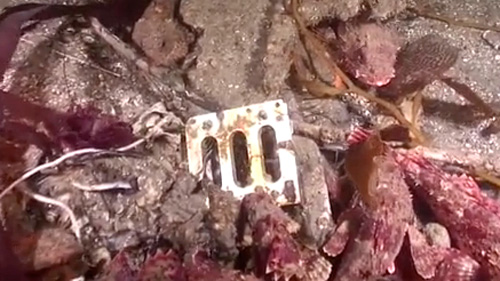
Aircraft electrical panel for exterior lighting circuits
We shot a bag and drifted through our deco. For some
reason, I couldn’t hear Sundiver II’s engines
overhead so I assumed Ray had realized the ball was
dragging early in the dive and was just drifting along
with our bag. Sure enough, he’d been tracking us
with sonar throughout the dive and was on top of the
bag when it surfaced.
Upon reviewing the video footage, we compiled a list of
evidence and believed we had indeed found our missing
plane. On the positive side the wreck was roughly where
it should be. We felt pretty sure the engine we found was
a Wright R-3350 and it also had a four bladed propeller.
What was disturbing was we hadn’t found the second
engine, wheel or any intact fuselage. Our plane ditched
and most of the crew survived. For that to happen the
fuselage had to have survived the ditching intact and
most likely the wing roots, engines and landing gear all
should have settled in close proximity on the bottom.
Since there was no evidence of nets on the wreck, the
chances of a fishing net having pulled away big sections
of the wreck seemed unlikely. Furthermore, we could find
no evidence that the piece of instrument panel John found
belonged to our plane.
Déjà vu all over again
A turn in the investigation came on December 10 when Gary
found detailed photos of a Wright R-3350 case along with
drawings of another engine which closely matched what
we’d found. The drawings clearly indicated what we
found was not a Wright R-3350, but a Pratt & Whitney
R-2800. This was the T-33 all over again. Having found a
plane where we expected it to be, we momentarily fell
into the trap of assuming that 2+2 equaled 4. It
didn’t.
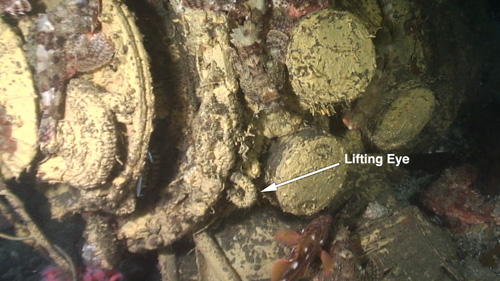
Lifting eye on engine
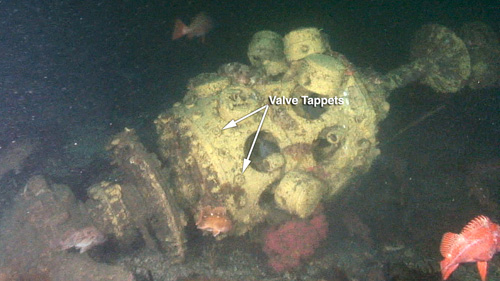
Valve tappets on engine
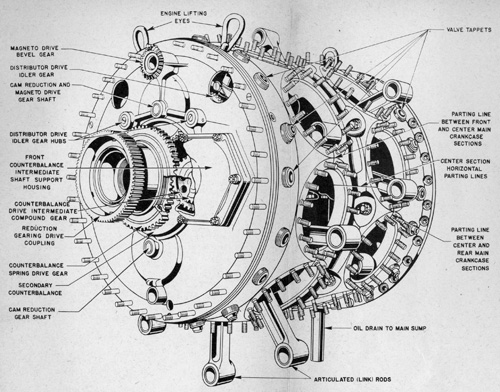
Crankcase drawing of Pratt & Whitney R-2800 engine
R-2800’s were never used on our target plane. They
were used on various other types including the F4U, F6F,
F8F, P-47, DC 6, B-26 and others. Our attention then
turned to the supercharger. With two opposing impellers,
the supercharger was a conventional two-stage two-speed
design consistent with the F4U-4 Corsair and the F6F
Hellcat. The Hellcat only had a three bladed propeller;
however. Our plane has a Hamilton Standard four bladed
propeller.
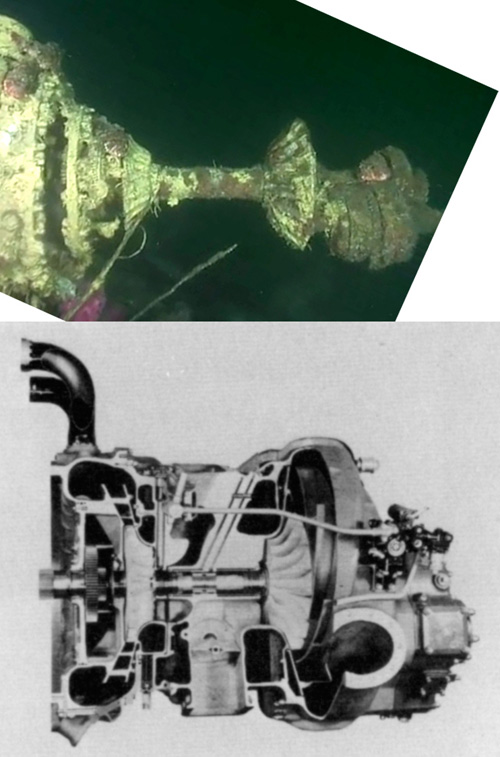
Comparison of engine (top) and a Pratt & Whitney
R-2800 supercharger cutaway (bottom)
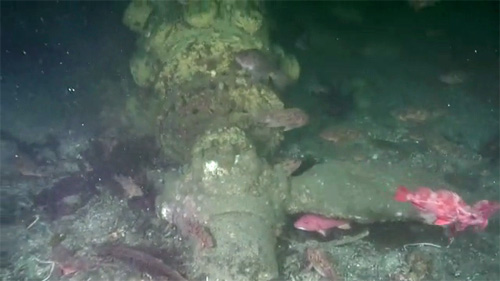
Remains of a Hamilton Standard 4-bladed propeller
The “dash 4” was also the first Corsair to
utilize a four bladed prop. Corsair’s were flown
extensively by Marine Corps and Naval aviators during
both WWII and Korea. With a service career of ten years,
there were lots of Corsairs buzzing around Southern
California. We then turned to aviation expert Pat Macha
to see if he had any records of Corsair losses in the
immediate area. Pat sent us everything he had, but
nothing was directly on point.
The Picture Emerges
Finally, after days of searching Gary found two Los
Angeles Times articles from 1950 describing the loss of
an F4U Corsair and subsequent search in the Dana Point
area. Gary relayed the information back to Pat who
contacted Craig Fuller at AAIR who was able to get us the
Navy accident report within hours.
The aircraft was an F4U-4B piloted by Ensign Charles
E. Butler based at NAS North Island, San Diego, CA.
Planes Search
Coast for Navy Fighter Pilot
Los Angeles Times
February 12, 1950
An intensive air-sea search for an F4U Navy fighter
missing since 2:30 pm Friday was in progress yesterday
with 19 planes, Coast Guard cutters and a helicopter
combing the rocky coastline near Dana Point. Naval
Officials said the plane was on a training flight from
the Naval Air Station at North Island, San Diego. The
pilot and sole occupant was identified as Ensign Charles
Emery Butler, 22, of Baggs, Wyo. Butler was flying in
formation with another Navy ship over the coastline
Friday afternoon.
Search for
Missing Plane Abandoned
Los Angeles Times
February 14, 1950
SAN DIEGO, Feb 14 (AP)- Search was abandoned today for a
missing Navy F4U Corsair fighter plane missing since
Friday. Navy officers expressed belief the plane, piloted
by Ensign C.E. Butler, 22, of Baggs, Wyo., crashed into
the sea after disappearing in clouds near Santa Ana from
other fighters in a training flight of
five.
Now we were getting somewhere. We had a documented
missing aircraft that matched the engine, supercharger
and propeller configuration of the wreck. The tire and
oil cooler are also consistent with an F4U. But we still
had a piece of instrument panel which decidedly did not
match anything visible inside the cockpit of any F4U
variant. The instrument panels in the F4U are black metal
with white lettering. The panel observed on the wreck
appears to be white plastic with black lettering. The
resistance markings on the panel matched the
builder’s specifications for the Corsair lighting
circuits, so we were pretty confident we had a piece of
an F4U. Without placing the piece; however, we
didn’t want to go public with the story. We’d
mis-ID’d the plane once and were uncomfortable with
a piece that didn’t fit.
Finally, the “Rosetta Stone” spoke. On
January 3, 2011, Julie Chaminand from ClassicFighters.org relayed a photo
from Commander Doug Matthews of a resistor block
currently being installed in an F4U restoration. The
photo was taken for us by aircraft restoration expert
John Lane at Airpower Unlimited in Jerome, ID. It was
a perfect match. The resistor block mounts inside the
electrical control box of an F4U Corsair. No doubt
about it. No wonder we couldn’t find it in any
photos. At this point we had eliminated the only
remaining contradiction.
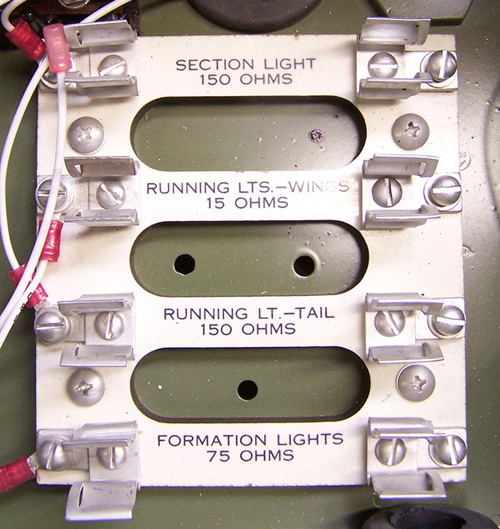
F4U Corsair resistor block. Photo courtesy of John Lane.
All the evidence we had indicated this was the F4U-4B
piloted by Ensign Butler. Nothing we had suggested
otherwise. From the newspaper clippings we started our
search for surviving relatives in Baggs, Wyoming, Ensign
Butler’s home town. Through the fine work of Dave
Mihalik, retired Assistant Police Chief of Irvine, CA,
and a member of Pat Macha’s aircraftwrecks.com search team, we
were able to locate Ensign Butler’s childhood
friend. Through the help of Baggs resident Linda
Fleming, Dave made contact with Jerry Wilson, 82, of
Yuma, AZ. Jerry told us Ensign Butler was an only
child and had no known living relatives. Shortly after
Ensign Butler’s disappearance Jerry traveled to
North Island, San Diego to inquire about the fate of
his friend. He spoke with a Navy chaplain, but was
given little information and was refused entrance to
the base. With nothing to go on, Jerry went home and
commissioned a memorial in Charles' name now located
in the cemetery in Baggs, Wyoming. In the waning years
of his own life, Jerry was very appreciative to learn
the final resting place of his missing friend Charles
Butler.
F4U Corsair plane wreck discovery from John Walker on Vimeo.
